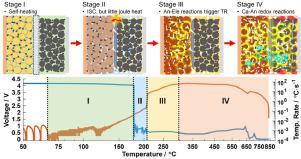Energy Storage Materials ( IF 18.9 ) Pub Date : 2020-10-22 , DOI: 10.1016/j.ensm.2020.10.020 Dongsheng Ren , Xuning Feng , Lishuo Liu , Hungjen Hsu , Languang Lu , Li Wang , Xiangming He , Minggao Ouyang

|
Thermal runaway, a critical problem that hinders the application of lithium-ion battery, is always a thermal-electrical coupled process where exothermic chemical reactions and internal short circuit coincide and interact with each other. Clarifying the contributions of chemical reactions and internal short circuit to thermal runaway is crucial for developing safer lithium-ion battery. In this paper, the relationship between internal short circuit and thermal runaway of lithium-ion battery under thermal abuse condition is investigated through experimental and modeling approaches. Internal short circuit is observed to happen before thermal runaway but leads to little heat generation during thermal abuse test of a lithium-ion battery with Li(NiCoMn)1/3O2 cathode. Liquid-nitrogen-ceased thermal runaway test and postmortem analysis are designed to characterize the cause of internal short circuit. Thermal shrinkage of the separator is found responsible for the occurrence of internal short circuit. However, the joule heat from internal short circuit is limited by the sharp-increased battery resistance and thus contributes little to battery thermal runaway. Moreover, exothermic reactions between the anode and electrolyte are determined as the trigger of thermal runaway of the Li(NiCoMn)1/3O2–based battery, in contrast to the conventional views that the highly reactive oxygen released from cathode or internal short circuit is the critical factor for thermal runaway of lithium-ion battery. Finally, a model-based discussion on the effect of internal short circuit on the thermal runaway of batteries with different designs is presented. The results provide new insights into battery thermal runaway mechanism and can benefit the safety design of lithium-ion battery.
中文翻译:

研究热滥用条件下锂离子电池内部短路与热失控的关系
热失控是阻碍锂离子电池应用的一个关键问题,始终是热电耦合过程,放热化学反应和内部短路同时发生并相互作用。澄清化学反应和内部短路对热失控的影响对于开发更安全的锂离子电池至关重要。通过实验和建模方法研究了锂离子电池在热滥用条件下内部短路与热失控的关系。观察到内部短路是在热失控之前发生的,但是在使用Li(NiCoMn)1/3 O 2的锂离子电池进行热滥用测试期间几乎不会产生热量阴极。液氮引起的热失控测试和事后分析旨在表征内部短路的原因。发现隔板的热收缩是内部短路发生的原因。但是,内部短路产生的焦耳热受到电池电阻急剧增加的限制,因此对电池热失控的贡献很小。此外,阳极和电解质之间的放热反应被确定为Li(NiCoMn)1/3 O 2热失控的触发因素电池,与传统观点相反,阴极或内部短路释放出的高活性氧是锂离子电池热失控的关键因素。最后,针对不同设计的电池内部短路对热失控的影响,进行了基于模型的讨论。结果为电池热失控机理提供了新的见解,并且可以有益于锂离子电池的安全设计。











































 京公网安备 11010802027423号
京公网安备 11010802027423号